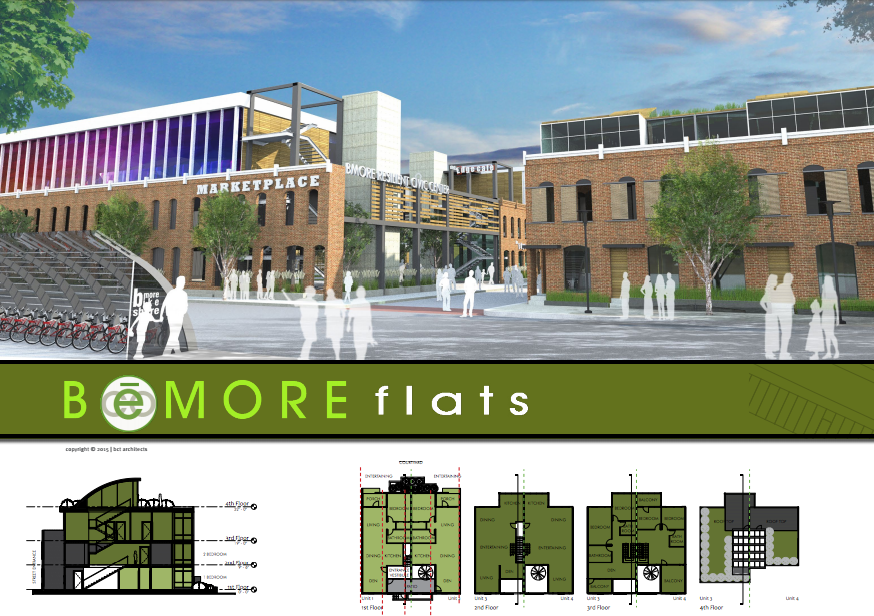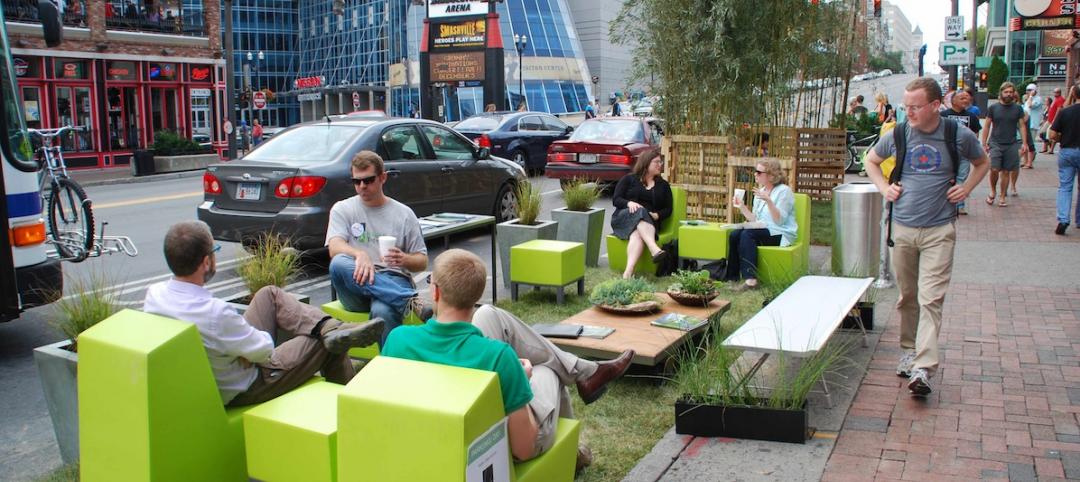Baltimore’s chapter of the AIA announced the winners of its B-More | Resilient Rowhouse Design Competition, where entrants provide environmental design solutions for the city’s vacant rowhouses in the Broadway East Neighborhood.
The competition was hosted by Baltimore City Planning Department, Office of Housing and Community Development, Office of Sustainability, and the Morgan State University School of Architecture + Planning. Four winners were chosen, one for each of these categories: Most Resilient Concept, Most Feasible Design, Most Innovative Design, and, the main category, Most Resilient Design.
A team of students from Virginia Tech and local architects from Brown Craig Turner submitted the BeMORE Flats design, which won the Most Resilient Design award. Their plan included green roofs, pedestrian-friendly streets, reclaimed alleys and courtyards, rain gardens, and salvaged wood decking. Plans called for one- and two-bedroom units, with community facilities.
“Although the competition focused on a specific neighborhood, winning designs presented solutions that can be repeated across Baltimore,” AIA Baltimore said in a statement. “To that extent, Morgan State faculty and students plan to analyze the constructability and cost of implementing the winning designs and present their findings to the city. The sooner the urban fabric of Baltimore can adapt to environmental and social challenges, the more resilient the city can be.”
The competition also had three honorable mentions and received more than 20 entries. The jury was made up of city representatives and architecture professionals and educators. AIA Baltimore’s website has a listing of all the entrants and their project plans.
Baltimore has a wide range of rowhouse styles that have been built since the 1700s. Many rowhouses, however, are vacant and have been torn down.
Related Stories
Multifamily Housing | May 28, 2015
Census Bureau: 10 U.S. cities now have one million people or more
California and Texas each have three of the one-million-plus cities.
Smart Buildings | May 27, 2015
Tactical urbanism: Why bigger isn’t always better in urban revitalization
A budding urban planning movement that is sprouting in cities across the globe proves that low-cost, small-scale, community-driven projects have the power to effect positive change.
Healthcare Facilities | May 27, 2015
Roadmap for creating an effective sustainability program in healthcare environments
With a constant drive for operational efficiencies and reduction of costs under an outcome-based healthcare environment, there are increasing pressures to ensure that sustainability initiatives are not only cost effective, but socially and environmentally responsible. CBRE's Dyann Hamilton offers tips on establishing a strong program.
Healthcare Facilities | May 27, 2015
Rochester, Minn., looks to escape Twin Cities’ shadow with $6.5 billion biotech development
The 20-year plan would also be a boon to Mayo Clinic, this city’s best-known address.
BIM and Information Technology | May 26, 2015
Moore's Law and the future of urban design
SmithGroupJJR's Stephen Conschafter, urban designer and planner, discusses his thoughts on the 50th anniversary of Moore's Law and how technology is transforming urban design.
Smart Buildings | May 21, 2015
Resiliency and climate change: Dual perspectives from designers at HDR
Two geographies, two perspectives, one conclusion: from Minnesota to Miami, resiliency matters, write HDR's Bob Beduhn and Lynette Cardoch.
Smart Buildings | May 1, 2015
FEMA to require states to evaluate risks posed by climate change
The aim is for states to do a better job planning for natural disasters they are likely to face in a warming world.
Smart Buildings | Jan 7, 2015
NIBS report: Small commercial buildings offer huge energy efficiency retrofit opportunities
The report identifies several barriers to investment in such retrofits, such as the costs and complexity associated with relatively small loan sizes, and issues many small-building owners have in understanding and trusting predicted retrofit outcomes.
Smart Buildings | Jan 7, 2015
Best practices for urban infill development: Embrace the region's character, master the pedestrian experience
If an urban building isn’t grounded in the local region’s character, it will end up feeling generic and out-of-place. To do urban infill the right way, it’s essential to slow down and pay proper attention to the context of an urban environment, writes GS&P's Joe Bucher.
BIM and Information Technology | Dec 28, 2014
The Big Data revolution: How data-driven design is transforming project planning
There are literally hundreds of applications for deep analytics in planning and design projects, not to mention the many benefits for construction teams, building owners, and facility managers. We profile some early successful applications.

















